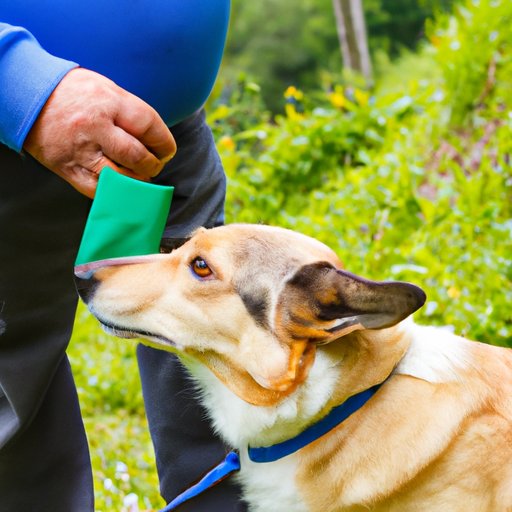Introduction
Pet owners know that ticks can be a real menace, especially during summer when they’re most active. Ticks can transmit diseases and cause infections in your dog, making it crucial for pet owners to know how to remove and prevent them. This article is a useful guide for pet owners on how to remove ticks from dogs effectively and efficiently.
The basic tools needed for tick removal
The first step to removing ticks from dogs is to have the proper tools. The essential supplies for tick removal include tick removers, tweezers, and rubbing alcohol. Tick removers are specifically designed to remove ticks from dogs. Tweezers are equally important as they help grasp the tick at the right place to avoid squeezing the tick’s body, which can increase the chances of disease transmission. Rubbing alcohol is also useful for disinfecting the bite area.
To use the tick remover, place it around the tick’s body, close to the skin, and twist the tool to remove the tick. When using tweezers, grasp the tick as close to the skin as possible and pull gently until the tick releases its hold. It’s essential to avoid squeezing or twisting the tick, as it can increase the risk of transmitting diseases.
Step-by-step guide to removing ticks
Removing ticks from dogs can be a daunting task, especially for new pet owners. However, by following these simple steps, you can safely and efficiently remove ticks from your dog:
Preparing for tick removal
Before removing the tick, ensure you have all the necessary tools. Wear gloves to avoid disease transmission from the tick to you. Find a well-lit area where you can easily locate and remove the tick, and have someone hold the dog steady, or use a leash to keep it from moving.
Grasping the tick
Use the tick remover or tweezers to hold the tick as close to the skin as possible, then pull gently upwards to remove the tick. Avoid squeezing or twisting the tick’s body. If you’re using tweezers, ensure not to squeeze the tick’s body, as it can increase the risk of transmitting diseases.
Removing the tick
Once you have a good grip on the tick, pull it upwards with steady pressure. Avoid yanking, as it can leave parts of the tick embedded in the skin. If the tick’s head remains in the skin, try using the tick remover or tweezers again to grasp and remove it.
Disinfecting the bite area
After removing the tick, disinfect the bite area with rubbing alcohol or mild soap and warm water. Keep an eye on your dog for a few days to ensure that no redness or inflammation develops.
Helpful tips
When removing ticks, use fine-tipped tweezers or a tick removal tool to avoid leaving tick parts in your dog’s skin. If you notice any swelling or redness around the bite area, consult your veterinarian. Lastly, you can save the tick in a bag for your vet to examine, especially if there is an infection.
Using natural remedies for tick removal
Natural remedies can be equally effective in removing ticks from your dog. Some popular natural remedies include vinegar, essential oils, and herbal sprays. These remedies work by suffocating the tick or making it easier to remove.
Vinegar works by changing the tick’s natural pH balance, causing it to die eventually. To use vinegar, mix equal parts of vinegar and water and spray it on the tick. Wait for a few minutes before removing the tick with fine-tipped tweezers or a tick removal tool.
Essential oils such as lavender, lemon, and peppermint are also useful as they can repel ticks. Apply a few drops of the oil on your dog’s collar or rub it on their fur before going outside. Herbal sprays made with rose geranium and lemongrass are effective too.
Preventing tick infestations on your dog
Preventing ticks from latching onto your dog is the best way to protect your pet from tick-borne illnesses. Pet owners can prevent tick infestations by using tick repellents containing permethrin. You can also spray your yard with tick-killing sprays and regularly mow your lawn to prevent ticks from hiding in the grass.
What to do after removing a tick
After removing a tick, it’s important to disinfect the bite area and monitor your dog for signs of illness. If you’re unsure about whether the tick is a carrier of any diseases, take it to your veterinarian for examination. Common tick-borne illnesses include Lyme disease, Rocky Mountain spotted fever, and Ehrlichiosis. Pet owners should also keep an eye on their dog for a few weeks to ensure they don’t develop any illnesses.
Common mistakes to avoid when removing ticks
Removing ticks requires precision and care. Some common mistakes that pet owners make when removing ticks include squeezing the tick’s body or twisting it. These mistakes can increase the chances of disease transmission. It’s important to avoid these mistakes by using fine-tipped tweezers or a tick removal tool and grasping the tick as close to the skin as possible. If you’re unsure about how to remove the tick, seek help from your veterinarian.

The importance of regular tick checks
Regular tick checks are crucial for pet owners, as they can help detect and remove ticks before they transmit any diseases. You should check your dog for ticks by running your hands over its fur, especially around the neck, ears, and belly. Check for any bumps or lumps and inspect them closely for ticks. If you find a tick, remove it immediately using a tick removal tool or fine-tipped tweezers.
Conclusion
Ticks can pose a significant threat to your dog’s health if not removed and prevented. Pet owners should take necessary steps to remove ticks properly and prevent them from latching onto their dogs. By following the steps outlined in this article and regularly inspecting your dog for ticks, pet owners can keep their dogs safe and tick-free.
